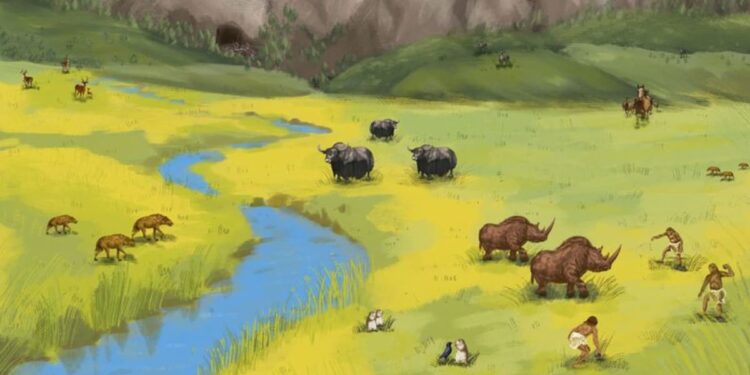Table of Contents
What recent discoveries shed light on the cultural and creative abilities of Neanderthals?
Unveiling the Lifestyle of Mysterious Extinct Humans: A Fascinating Study
In the vast tapestry of human history, there have been several species that have come and gone, leaving behind traces of their existence and captivating the imagination of scientists and archaeologists. One such group of extinct humans, often described as our “cousins,” continues to intrigue researchers with their mysterious lifestyle and behaviors. In this article, we delve into the fascinating world of these extinct humans, exploring their lifestyle, habitat, and the evidence that reveals their presence.
The Extinct Humans: Neanderthals
Among the most famous and well-studied extinct humans are the Neanderthals. These robust and distinct breed of humans lived in Europe and parts of Asia between 400,000 and 40,000 years ago. Neanderthals were well-adapted to the cold climates of the last Ice Age and possessed several unique characteristics that set them apart from modern humans.
Lifestyle and Habitat
The Neanderthals were a highly adaptable species, capable of surviving and thriving in a variety of environments. They primarily inhabited open grasslands and denser forested areas, adapting their lifestyle to suit their surroundings. The evidence suggests that they were skilled hunters and gatherers, relying on a diverse diet of large game such as mammoths, deer, and bison, as well as foraging for nuts, fruits, and tubers.
Neanderthals lived in temporary shelters such as caves, rock overhangs, and natural depressions. They would often modify the interior of their shelters to make them more comfortable, potentially using animal hides and plant materials for insulation. The archaeological record also suggests that they had a sophisticated tool-making culture, crafting stone tools and weapons for hunting and other activities.
Interactions with Modern Humans
One of the most intriguing aspects of Neanderthal life is their interaction with our own species, Homo sapiens. Recent studies have shown that Neanderthals and modern humans co-existed in certain regions for thousands of years, leading to possible interbreeding events. DNA analysis has revealed that modern humans of non-African descent carry fragments of Neanderthal DNA, suggesting that interbreeding did occur.
Evidence of Culture and Creativity
Contrary to popular belief, Neanderthals were not simply primitive brutes. Recent discoveries have shed light on their cultural and creative side. Evidence of symbolic behavior, such as cave art, has been discovered in caves once occupied by Neanderthals. Examples of elaborate bone and ivory carvings have also been found, demonstrating their artistic abilities.
Furthermore, studies have revealed that Neanderthals had a complex social structure and engaged in burial rituals, indicating a level of cognitive and emotional capacity similar to that of early modern humans.
Practical Tips for Neanderthal Studies
If you’re fascinated by Neanderthals and want to learn more about their lifestyle and behaviors, here are some practical tips:
- Visit museums and exhibitions dedicated to human evolution. These often have informative displays and interactive exhibits on Neanderthals.
- Read books and scientific articles on Neanderthal research. There are several popular science books available that summarize the latest findings in an accessible manner.
- Participate in scientific fieldwork or volunteer at archaeological sites. This hands-on experience can provide valuable insights into the research process and allow you to contribute directly to our understanding of extinct humans.
- Engage with online communities and forums dedicated to human evolution. These platforms are a great way to connect with fellow enthusiasts and experts in the field.
Case Studies: Famous Neanderthal Sites
The study of Neanderthals is not limited to academic research. Several famous archaeological sites provide firsthand experiences into this extinct species:
| La Ferrassie | A site in France where several Neanderthal skeletons were discovered, offering valuable insights into Neanderthal anatomy and behavior. |
| Shanidar Cave | Located in the Zagros Mountains of Iraq, Shanidar Cave provided evidence of Neanderthal burial practices and potential ritualistic behavior. |
| Denisova Cave | Situated in Siberia, Denisova Cave revealed the existence of a distinct group of extinct humans known as the Denisovans, who interbred with both Neanderthals and modern humans. |
Disclaimer: Due to ongoing research and new discoveries, the information provided in this article may be subject to change or updates.
Conclusion
The study of extinct humans, such as the Neanderthals, provides us with valuable insights into our own evolutionary history. Through careful examination of their lifestyle, habits, and interactions with modern humans, we gain a deeper understanding of the complexity and diversity of early human cultures. By unveiling the mysteries of these ancient species, we connect more closely with our own origins and the shared human story that spans millennia.
The Mystery of the Denisovans: A Journey Through Time and Geography
The enigmatic Denisovans are only recognizable through a collection of dental remains and bone fragments found in the Baishiya Karst and Denisova caves and Cobra Cave in Laos. Despite their limited physical evidence, their presence in such diverse and distant locations indicates a remarkable geographic spread.
At a high latitude in Siberia, a high altitude on the Tibetan Plateau, and a subtropical setting in Laos, the Denisovans’ presence suggests an impressive ability to thrive in different environments, as claimed by Zhang.
A previous discovery of a lower jaw belonging to a Denisovan adolescent at Baishiya Karst dates back 160,000 years, leading researchers to estimate that Denisovans could have inhabited the area as early as 200,000 years ago. The recent identification of a rib fragment indicates that Denisovans were present as recently as 48,000-32,000 years ago.
This rib fragment, a first of its kind, presents a new addition to the limited collection of Denisovan remains, which previously consisted solely of dental, cranial, or mandibular (lower jaw) specimens. Welker mentioned that the gender and age of the rib’s owner remain unknown.
Unlike our species, Homo sapiens, which emerged in Africa over 300,000 years ago and later reached the Tibetan Plateau approximately 40,000 years ago, the fate of the Denisovans remains mysterious.
Welker acknowledged the lingering questions surrounding the Denisovans’ extinction, expressing the limited knowledge about their interbreeding with modern humans based on existing Denisovan DNA present in the genomes of some contemporary individuals. However, the exact timing, location, and reason for the Denisovans’ extinction remain elusive.






